Yoga for Arthritis
May 31, 2018 2024-02-18 14:53Yoga for Arthritis
Arthritis is a global epidemic with women being more prone to the condition than men. Arthritis is not a disease, but a group of painful conditions, including fibromyalgia, gout, osteoarthritis, and rheumatoid arthritis. Lack of adequate care could lead to slow erosion of quality of life.
But the good news is that yoga could help to ease the pain and inflammation, thus enhancing the quality of life. Before we understand more about how yoga can benefit those with arthritis, let us take a quick glance at the symptoms of arthritis.
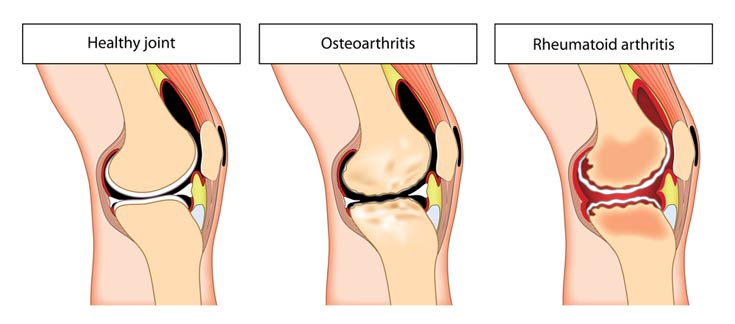
Signs and Symptoms of Arthritis
Some of the most reported signs and symptoms of arthritis are:
- Painful inflammation of joints
- The stiffness of the affected area
- Redness around the affected zone
- Tenderness and swelling
- Restricted range of movements
- Muscle weakness
- Difficulty in walking
- Insomnia
- Reduced digestive power
- Increased digestive issues, including susceptibility to IBS
The good news here is that yoga could help to ease and managing all the symptoms of arthritis outlined above, thereby enhancing the life’s quality.
Benefits of Yoga For Arthritis
Some of the benefits you could enjoy by making yoga a part of your life include:
- Lesser pain and inflammation
- Better range of movement
- Better physique
- Eases stiffness
- Better flexibility
- Could ease digestive issues
- Could help with weight loss
- Reduce stress
- Could restore the balance of the body and mind
- Could help with better depression management
- Enhanced overall quality of life
Yoga Poses For Arthritis

1. Tadasana – Mountain Pose
It could improve blood circulation while stretching and strengthening the joints and muscles. The better the flow of blood is, the better the movement will be. Enhanced blood circulation could also lower the pain as well. The posture could help in rectifying postural issues while gifting better flexibility.
Stand straight with your feet separated one-palm apart. Press your feet into the mat while elongating your spine to the ceiling. Allow the arms to rest on either side of the body, palms facing the thighs. Roll the shoulders down and back, bringing your shoulder blades together. Engage your core and thigh muscles.
Inhale and swing your arms overhead. Join your palms. Close your eyes and take five to ten deep breaths. Once you are comfortable, lift your heels and try to balance on your toes. If possible, close your eyes and balance. Or else, focus on the space between the eyebrows. Hold the posture for ten deep breaths.
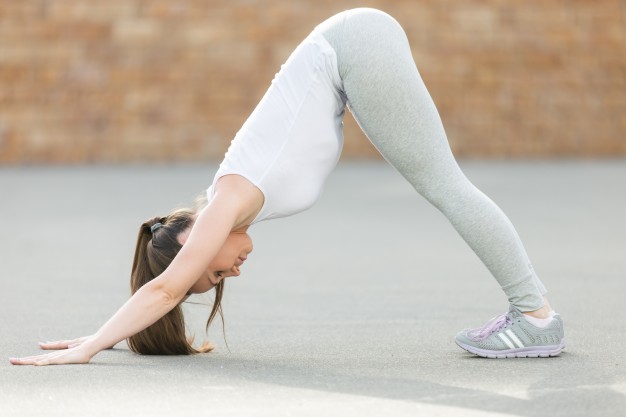
2. Adho Mukha Svanasana – Downward Facing Dog Pose
The Asana stretches your entire body while improving circulation. Make a micro-bend on your knees if you experience pressure on your lower back.
Come on all the fours, stacking your shoulders over your wrists. Separate your knees hip-width apart. Tuck your toes. Lengthen through your spine, keeping it neutral. Pressing the palms into the mat, inhale, and push your hips to the ceiling. Breathing through the nose, lengthen through the spine, and press the heels into the mat. Keep your arms straight, aligning wrists, elbows, and shoulders in a straight line. Let the head hang between your elbows. Rest the abdomen on your thighs. Gaze at your thighs.
Pull the muscles of your stomach towards your spine and open your chest by rolling down the shoulders. Breathe and hold the posture for the next ten breaths.
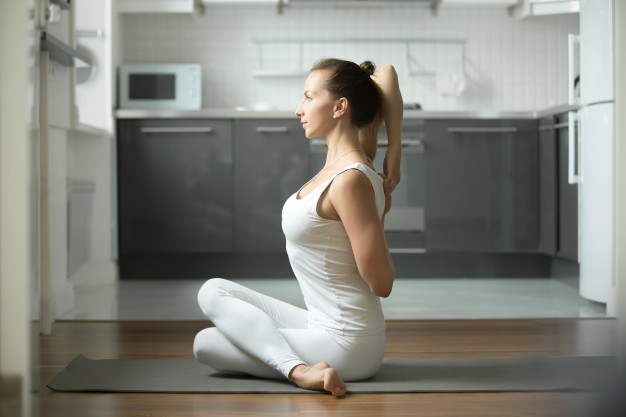
3. Gomukhasana – Cow Face Pose
It is a seated yoga posture that opens up the chest and could help to ease the stiffness in the back. While the actual position requires the practitioner to sit down stacking the knees, you could choose to sit in simple cross-legged position, if the
Sit down, maintaining a straight spine. Stretch out the legs and rest the palms on either side of the hips. Lengthen your spine. Engage your core muscles. You’re your right knee and allow the right foot to rest close to your left sitting bones. Cross your left knee over your right and rest your left foot close to the right sitting bones. Rest your hips firmly on the mat. Adjust the posture so that knees are stacked.
Inhale and lift your left arm up. Bend it at the elbow and rest your left palm on your upper back. Bring your right hand towards the left arm from behind and interlace the fingers, if possible. If the fingers are not in contact, use a strap or a towel in such a way that you experience a stretch in your arms.
Roll your shoulders down and away to open the chest. Hold the Asana for the next ten breaths. At the end of the tenth exhalation, release the posture. Repeat on your other side.
Pranayama for Arthritis
There are three different Pranayama practices that you could follow for arthritis management. Each one is unique and has various benefits.

1. Kapalbhati:
According to Ayurveda, excess Vata or the air element in the body creates dryness in the joints and muscles, in turn leading to Arthritis. Kapalbhati, or skull cleansing breath, could promote elimination of excess air. It could also encourage detoxification, thus offering relief.

2. Anulom Vilom:
The Alternate Nostril Breathing is one of the most effective ways to calm the racing mind. It could also help alleviate the stress and depression associated with arthritis. Regular practice of this breathing technique could be beneficial for pain management as well.
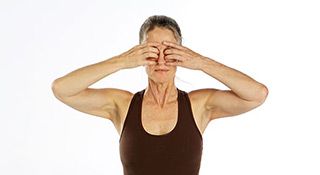
3. Bhramari Pranayama:
The Humming Bee Breath, as it is known in English, also works on calming stress and relieving anxiety. The beautifully powerful humming reverberates in your brain, stimulating the release of the tension.
Mudra for Arthritis
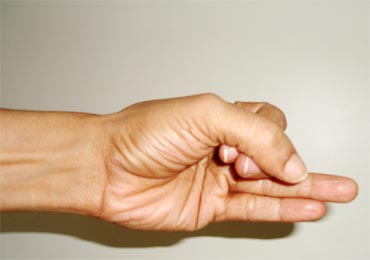
Vata Mudra
Vata Mudra is the Gesture of Air. Ancient texts suggest that regular practice of this Mudra could help in releasing the excess air from your body. It could also help to ease insomnia triggered by arthritis.
Sit down in a comfortable seated posture, maintaining an erect spine to allow free flow of energy. Rest the tops of your palms on your knees. Fold the index and middle fingers toward the center of the palm and rest them at the base of the thumb. Bend your thumb as well. Press both the fingers with your thumb. Stretch out rest of the fingers. Close your eyes and meditate for the next 15 to 45 minutes.
It is ideal to practice the Mudra on an empty stomach. You can either practice it for 45 minutes continuously or thrice a day, 15 minutes each.
These were some simple yoga asanas that could help people with arthritis. Try them and see the difference yourself.
Search
Popular posts

Popular tags



Comment (1)
Shruti Sagar
Excellent information!
Comments are closed.